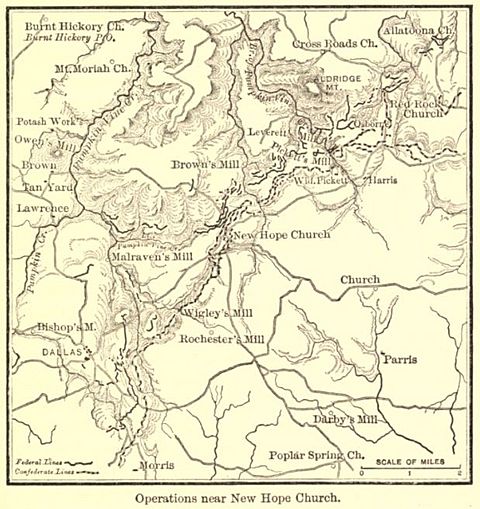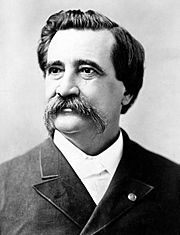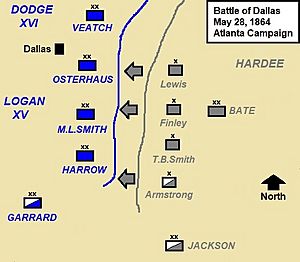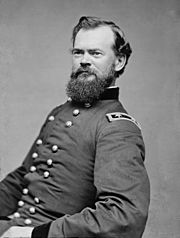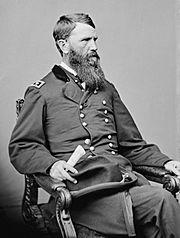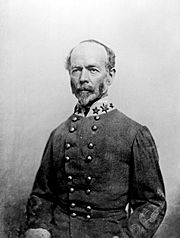Battle of Dallas facts for kids
Quick facts for kids Battle of Dallas |
|||||||
|---|---|---|---|---|---|---|---|
| Part of the American Civil War | |||||||
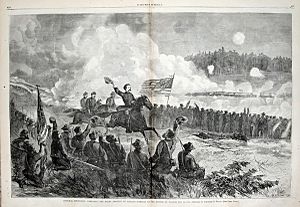 General Logan at the Battle of Dallas, May 1864 |
|||||||
|
|||||||
| Belligerents | |||||||
| Commanders and leaders | |||||||
| William T. Sherman John A. Logan |
Joseph E. Johnston William B. Bate Frank C. Armstrong |
||||||
| Units involved | |||||||
| Military Division of the Mississippi | Army of Tennessee | ||||||
| Strength | |||||||
| Dallas: ~11,500 May 23–June 6: ~100,000 |
Dallas: ~10,000 May 23–June 6: ~65,000 |
||||||
| Casualties and losses | |||||||
| Dallas: 379 May 23–June 6: 4,500 |
Dallas: 1,000–1,200 May 23–June 6: 3,000 |
||||||
The Battle of Dallas was a fight during the Atlanta Campaign of the American Civil War. It happened on May 28, 1864, in Paulding County, Georgia. This battle was part of a larger series of clashes between the Union Army led by General William Tecumseh Sherman and the Confederate States Army led by General Joseph E. Johnston.
These battles took place between May 25 and June 3, 1864. They stretched from Dallas northeast toward Acworth, Georgia. At Dallas, a Confederate attack, meant to be a small probe, turned into a large assault. It hit the strong defenses of General John A. Logan's Union troops. The Confederates were pushed back with heavy losses. The earlier Union defeats at New Hope Church and Pickett's Mill are sometimes grouped with Dallas as one big battle.
On May 23, General Sherman tried a wide move to get around Johnston's army. Johnston quickly moved his troops to Dallas to stop Sherman. This led to ten days of tough fighting. After the Dallas battle, Sherman moved his army northeast. He was looking for a way to get around Johnston's strong defenses. On June 1, Union forces took control of Allatoona Pass. This allowed them to repair the railroad and get supplies by train. By June 3, Union troops were in a good position to flank Johnston. This forced Johnston to leave his lines and move back to a new defensive spot near Marietta.
Contents
The Armies in Georgia
During the Civil War, two main armies faced each other in Georgia. General William Tecumseh Sherman led the Union forces. General Joseph E. Johnston commanded the Confederate Army of Tennessee.
Union Forces
General Ulysses S. Grant, the top Union general, told Sherman to attack Johnston's army. Sherman's goal was to break up the Confederates and move deep into their territory. He wanted to cause as much damage as possible. Sherman's army was made up of three main groups. These were the Army of the Cumberland, the Army of the Tennessee, and the Army of the Ohio.
Each of these armies had different parts called corps. For example, the Army of the Cumberland had the IV, XIV, and XX Corps. The Army of the Tennessee had the XV and XVI Corps. The Army of the Ohio had the XXIII Corps. These corps had thousands of soldiers. For example, the XIV Corps had about 22,000 men.
Confederate Forces
General Johnston's Army of Tennessee was also organized into corps. These were led by generals like William J. Hardee and John Bell Hood. Johnston's army also had cavalry, which are soldiers on horseback. Later, more troops joined Johnston's army. These came from the Army of Mississippi.
Sherman's Plan and Early Fights
Sherman started his campaign on May 7, 1864. He began by trying to get around Johnston's army at Battle of Rocky Face Ridge. When Johnston pulled back, they fought at the Battle of Resaca. Sherman kept trying to go around Johnston's side. Johnston was good at moving his army to block Sherman.
On May 19, Johnston moved his army to a very strong defensive spot. This was at Allatoona Pass. It was a narrow gorge where the railroad ran. Sherman wanted to force Johnston to retreat even further. So, he decided to try to go around Johnston's army again. This time, he planned to march to Dallas and then Marietta.
On May 23, Sherman's army left its railroad supply line. They carried 20 days of food and supplies in wagons. Sherman sent his wounded soldiers to the back. He ordered his troops to march south and east toward Dallas. Cavalry (soldiers on horseback) rode ahead to scout the area.
Johnston quickly learned about Sherman's move. He ordered his army to march southwest to Dallas. The Confederates marched all day and night to get into position. On May 24, Union cavalry found Confederate soldiers already at Dallas. Sherman still thought Johnston wouldn't stop him there. He told his army to keep pushing forward.
Battles in Late May
New Hope Church
By May 25, Johnston's army was dug in with strong defenses near Dallas. General Hood's Confederate corps arrived at New Hope Church. They quickly dug trenches and built walls of earth for protection. Union troops, led by General Joseph Hooker's XX Corps, approached Hood's position.
Sherman ordered an attack, thinking there were only a few Confederates there. But Hood's 4,000 soldiers, led by General Alexander P. Stewart, were ready. They had 16 cannons. At 5 pm, 16,000 Union soldiers attacked through thick woods. They were met with a storm of rifle and cannon fire. The Union soldiers had to hit the ground and fire back. The battle lasted three hours, even through a thunderstorm. Hooker's Union forces lost 1,665 men. The Union soldiers called the battlefield the "Hell Hole." Stewart's Confederates lost only 300-400 men.
Pickett's Mill
After the fight at New Hope Church, Sherman decided to try to get around Johnston's right side instead. He also wanted to reach the railroad again near Allatoona Pass. On May 27, Sherman ordered a new attack. General Thomas J. Wood's Union division was sent to attack Johnston's right flank.
What Sherman didn't know was that Johnston had already moved troops to strengthen his right side. General Patrick Cleburne's Confederate division was moved there. General Stewart's division also came to help. At 5 pm, Wood's division attacked. They marched through thick forests. But they ran into strong Confederate defenses. General William Babcock Hazen's Union brigade was pushed back by a Texas brigade. Other Union brigades also attacked but were beaten back.
The Battle of Pickett's Mill was another Union defeat. The Union army lost 1,600 soldiers. Many of them were killed. The Confederates reported 448 casualties.
The Battle of Dallas
After these tough battles, Sherman realized Johnston's whole army was dug in. So, Sherman planned to move his troops from his right side to his left side. His goal was to get beyond Johnston's right side and reach the railroad near Acworth. This would allow him to rebuild the railroad bridge and get supplies.
On the evening of May 27, Confederate cavalry reported that Sherman's left side was open. General Hood convinced Johnston to attack it. But during the night, the Union lines moved and built more defenses. So, Johnston called off Hood's attack.
On May 28, Johnston received reports that Sherman's right flank was moving north. These reports were wrong. But Johnston ordered General William B. Bate's Confederate division to check the Union defenses near Dallas. If the Union lines were empty or weak, Bate was to take them. Bate had about 5,000 men. General William Hicks Jackson's cavalry, also about 5,000 strong, was ordered to help.
Bate planned for the cavalry to attack first. If they met little resistance, four cannon shots would signal the infantry to attack. If they met strong defenses, no shots would be fired, and the attack would be canceled. Bate was sure they would only find a small force.
The Union defenses were held by General John A. Logan's XV Corps. These Union soldiers were well-dug in. A Confederate officer tried to warn that the Union lines were strong. But General Bate and others thought they faced only a small skirmish line.
At 3:45 pm, Confederate cavalry attacked Logan's division. They quickly overran the Union picket line and captured three cannons. They broke through a gap in the defenses. But General Logan quickly brought in more troops. He shouted, "Give them hell boys!" A Union counterattack pushed the Confederates back. They quickly retreated to their trenches.
After seeing this quick defeat, Bate ordered the signal cannons not to fire. He sent messages to his infantry brigades to cancel the attack. But two of his brigades, led by generals Joseph Horace Lewis and Jesse J. Finley, didn't get the message in time. They thought they missed the signal because of all the shooting. They ordered their troops to attack. Hundreds of them were shot down by Logan's well-dug-in soldiers.
Again and again, the Confederates tried to rush the Union lines. But they couldn't get closer than 50 yards. They finally stopped their attacks at 6 pm. The Union soldiers were impressed by the bravery of their enemies. They thought they had defeated a whole Confederate corps.
Johnston reported only 300 Confederate losses. But General Lewis's Kentuckians lost 51% of their 1,100 soldiers. Bate's division and Armstrong's cavalry lost at least 1,000 men, possibly as many as 1,500. Logan reported 379 Union casualties. The American Battlefield Trust says Union losses were 379 and Confederate losses were 1,200.
What Happened Next
The fighting at Dallas on May 28 made General James B. McPherson ask Sherman to delay his plan to shift troops. Sherman agreed. May 29 was spent with small skirmishes along the 10-mile front. Sherman rescheduled the troop shift for the night of May 31.
Meanwhile, Union cavalry moved to the far left side. They were ordered to head for Allatoona Pass. On the night of May 31, McPherson's troops carefully moved out of the Dallas area. They marched to new Union lines further north. By the morning of June 1, McPherson's move was happening without the Confederates knowing. That day, Union cavalry took Allatoona Pass. Repair work on the railroad line began.
On June 2, Union troops moved east. They pushed back Confederate skirmishers. They marched through thick forests. They found a line of Confederate trenches. They dug in themselves. On June 3, more Union troops arrived. Union cavalry reached Acworth. Sherman's engineers could now repair the railroad track all the way to Acworth.
Believing Sherman was about to get around his right side and take Marietta, Johnston ordered a 6-mile retreat on the night of June 3. On June 4, Sherman moved McPherson's troops to the far left side, near the railroad. Johnston's soldiers left their lines on the night of June 4. The Union soldiers didn't even realize they were gone. The Confederate retreat happened in the rain. The soldiers arrived at their new defenses muddy and tired.
Johnston's new line stretched from Lost Mountain to Brushy Mountain. Sherman rearranged his forces. The next big fight was the Battle of Gilgal Church on June 15.
Soldiers and Losses
Between May 23 and June 6, Sherman's Union forces lost about 4,500 soldiers. Johnston's Confederate army lost about 3,000 soldiers. In May, Sherman's army lost 12,000 men out of 100,000. Johnston's army lost 9,000 men out of 65,000-75,000. Sherman's losses were quickly replaced by new units. But Johnston's army mostly had to rely on Georgia state militia for new soldiers.
By early June, Sherman's army became stronger compared to the Confederate army. Even though Sherman lost more men, he had more ways to replace them. In the fighting around New Hope Church and Dallas, Johnston stopped Sherman's advance for two weeks. He did a good job of countering Sherman's moves. However, in May, Sherman's forces moved 80 miles into Georgia. They forced the Confederates to give up many strong defensive spots.
The tough fighting and hard conditions also made soldiers sick or exhausted. Many men from both armies were sent away because they were sick or tired. Some soldiers also ran away from the army. People from both armies stole from local homes.
On April 30, 1864, Sherman's forces had about 110,000 soldiers. About 99,000 of them were ready for fighting. There were also about 25,000 people who helped the army but didn't fight. These included railroad workers, medical staff, and teamsters.
On April 30, Johnston's Army of Tennessee had about 41,279 infantry, 8,436 cavalry, and 3,227 artillerymen. They also had about 8,000 people who helped the army but didn't fight. Johnston's army received some reinforcements during the campaign.
Battlefield Today
The place where the Battle of Dallas happened is now Paulding County High School. The old Confederate trenches are marked by a Civil War sign along Highway 61. The Civil War Trust and its partners have worked to save 64 acres of the battlefield.
Images for kids



